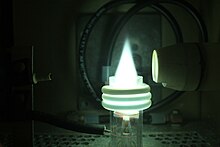Aninductively coupled plasma (ICP) or transformer coupled plasma (TCP)[1] is a type of plasma source in which the energy is supplied by electric currents which are produced by electromagnetic induction, that is, by time-varying magnetic fields.[2]

There are three types of ICP geometries: planar (Fig. 3 (a)), cylindrical [4] (Fig. 3 (b)), and half-toroidal (Fig. 3 (c)).[5]
In planar geometry, the electrode is a length of flat metal wound like a spiral (or coil). In cylindrical geometry, it is like a helical spring. In half-toroidal geometry, it is a toroidal solenoid cut along its main diameter to two equal halves.
When a time-varying electric current is passed through the coil, it creates a time-varying magnetic field around it, with flux
,
where r is the distance to the center of coil (and of the quartz tube).
According to the Faraday–Lenz's law of induction, this creates azimuthal electromotive force in the rarefied gas:
,
which corresponds to electric field strengths of
,[6]
leading to the formation of the electron trajectories[5] providing a plasma generation. The dependence on r suggests that the gas ion motion is most intense in the outer region of the flame, where the temperature is the greatest. In the real torch, the flame is cooled by the cooling gas from the outside , so the hottest outer part is at thermal equilibrium. Temperature there reaches 5 000 – 6 000 K.[7] For more rigorous description, see Hamilton–Jacobi equation in electromagnetic fields.
The frequency of alternating current used in the RLC circuit which contains the coil is usually 27–41 MHz. To induce plasma, a spark is produced at the electrodes at the gas outlet. Argon is one example of a commonly used rarefied gas. The high temperature of the plasma allows the atomization of molecules and thus determination of many elements, and in addition, for about 60 elements the degree of ionization in the torch exceeds 90%. The ICP torch consumes c. 1250–1550 W of power, and this depends on the element composition of the sample (due to different ionization energies).[7]
The ICPs have two operation modes, called capacitive (E) mode with low plasma density and inductive (H) mode with high plasma density. Transition from E to H heating mode occurs with external inputs.[8]
Plasma electron temperatures can range between ~6,000 K and ~10,000 K[citation needed] and are usually several orders of magnitude greater than the temperature of the neutral species[citation needed]. Temperatures of argon ICP plasma discharge are typically ~5,500 to 6,500 K[citation needed] and are therefore comparable to those reached at the surface (photosphere) of the sun (~4,500 K to ~6,000 K). ICP discharges are of relatively high electron density, on the order of 1015cm−3[citation needed]. As a result, ICP discharges have wide applications wherever a high-density plasma (HDP) is needed.
Another benefit of ICP discharges is that they are relatively free of contamination, because the electrodes are completely outside the reaction chamber. By contrast, in a capacitively coupled plasma (CCP), the electrodes are often placed inside the reactor chamber and are thus exposed to the plasma and to subsequent reactive chemical species.